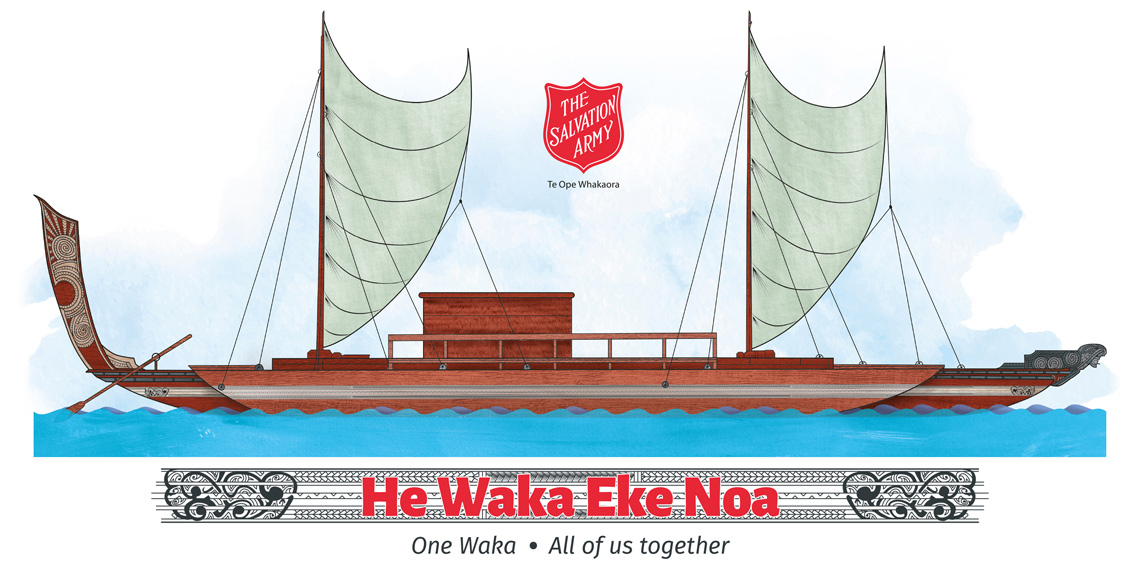Strategic Mission Framework
He Waka Eke Noa - One Waka - All of us together
Territorial Strategy
At the start of 2020, our Territorial Governance Board (TGB) met to start developing a territorial strategy. While we’ve had various Territorial Mission Plans in the past, and a series of 'We Commit statements were introduced at Congress in 2019, it was felt that an overall strategic framework would be helpful to provide focus for the territory and a framework to guide TGB decision-making.
Using an external facilitator, TGB spent the day in prayer and planning, and identified some key strategic issues, supported by a sense that we are better together.
Our Response
Mission
We remain committed to our mission: The Salvation Army, an international movement, is an evangelical part of the universal Christian church. Its message is based on the Bible. Its ministry is motivated by the love of God. Its mission is to preach the gospel of Jesus Christ and to meet human needs in his name without discrimination.
In the context of New Zealand, Fiji, Tonga and Samoa, we apply this through our shortened mission statement of caring for people, transforming lives and reforming society by God’s power.
Cultural Contexts
In the context of New Zealand, we uphold Te Tiriti o Waitangi (the Treaty of Waitangi) as the covenant on which our nation’s bicultural partnership is established. Te Ōhākī is our Māori Ministry Strategic Plan for 2015 to 2025 and will continue to be implemented as part of this strategy.
We also desire to be relevant to the cultures of Fiji, Tonga and Samoa, and all cultures represented across our four countries. We believe this can be achieved when we uphold Jesus Christ as the head of the Church, who, through the power of the Holy Spirit, unites all people.
Strategic Intent
Our intent is to be a faith-driven, inclusive and a unified Army that is:
- aligned and working together to achieve better mission outcomes
- a great place to belong, work, worship and serve
- progressing sustainably.

We are representing our intent as a waka. The waka is a symbol of unification. Everyone on the waka is going in the same direction, working together to achieve the same goal.
The above illustration depicts our strategy in pictorial form and incorporates aspects of the varying canoes across our countries—New Zealand, Fiji, Tonga and Samoa.
Our mission is out the front (the Tauihu/prow)—this is where we are heading. We are faith-driven, motivated by our love for God to care for people, transform lives and reform society by God's power.
The Taurapa (high extended stern) represents our Island nations. The designs identify our Pacific commitment.
The Urungi (rudder) represents our values—the commitments we have made about how we behave that help to steady and steer our course as we move forward in mission.
Recognising the different countries and cultures represented within our territory, the waka is carved with cultural designs from each of the countries.
Above the water line, flax (harakeke) is woven throughout the waka to give it strength and provide somewhere to attach things and work from. For New Zealand, this represents our Tiriti partnership, which needs to be woven throughout everything we do.
Our three strategic priorities are represented: Mission Impact (first sail); Our People (the pataka utanga [the storehouse of provision, preparation and the place of rest, when required]); and Sustainability (second sail).
He Waka Eke Noa derives from the Māori whakataukī (proverb), and refers to working in unity and leaving no one behind. The canoe which we are all in without exception. We rise together, fall together and keep going ... together.
Strategic Priorities
To embed this ‘one waka’ culture, we will focus on three strategic priorities.
- Increasing our Mission Impact
We will finish clarifying our desired mission outcomes, then pursue these relentlessly to increase our mission impact. - Being a great place for People to belong, work, worship and serve
We will continue our work to lift capability (particularly leadership), improve our recruitment and retention, and be more inclusive, to ensure our people rate us as a great place to belong, work, worship and serve. - Long-term Sustainability
We will reimagine our mission model to be more sustainable and redesign our support services to be effective and efficient.
We have simplified these to Mission Impact, People and Sustainability.
In New Zealand, our Tiriti partnership spans all three priorities.
